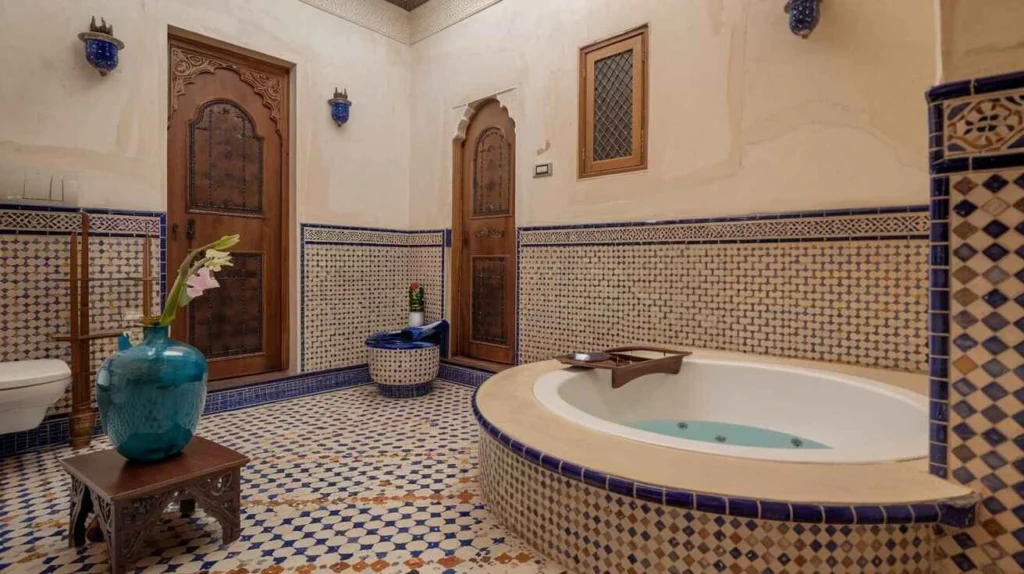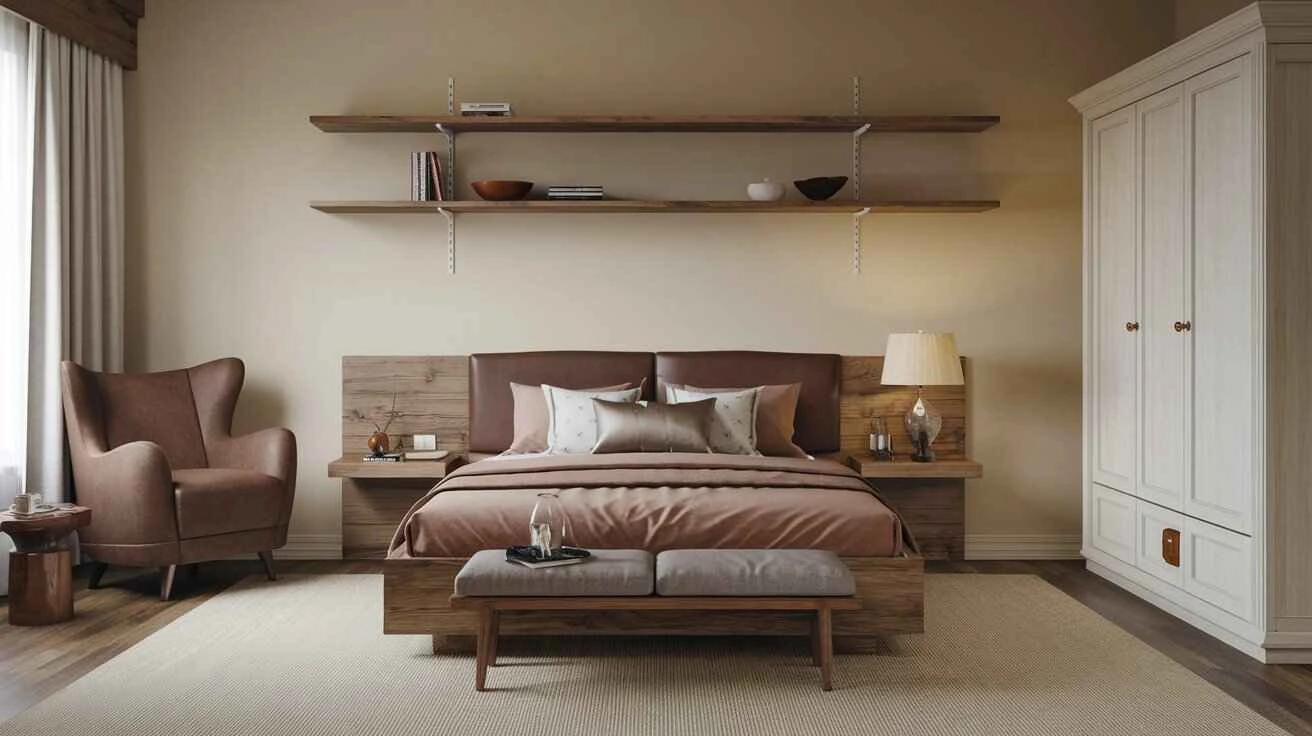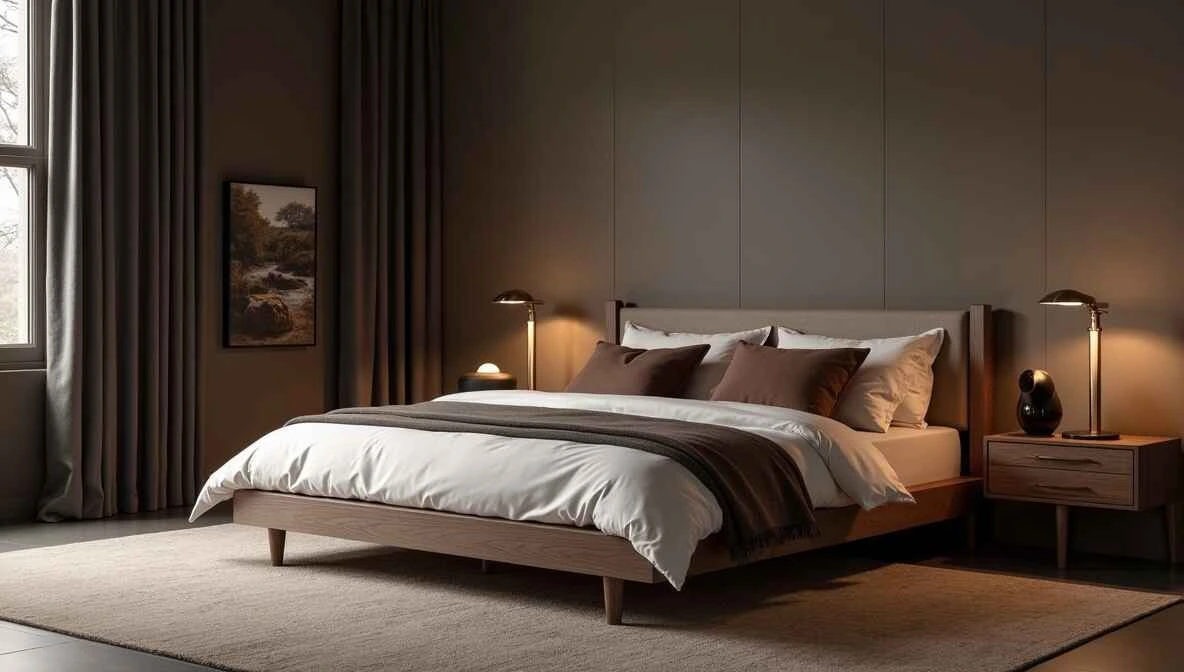Moroccan style is characterized by heavy use of bright colors, elaborate designs, and sumptuous fabrics. It can bring a vibrant, relaxing space to life in a bathroom that is long on charm but short on culture. Moroccan style brings a unique warmth and beauty to any bathroom by mixing traditional craftsmanship with modern touches.
15 Moroccan Style Bathroom Ideas for All Budgets and Sizes —This article will tell you about 15 Moroccan-style bathroom ideas that suit your bathroom size and portfolio. Whether it’s a complete design overhaul or just a few Moroccan-feel details, these tips will guide you to create a luxury bathroom.
What Does Moroccan Style Mean in Bathroom Design?
What is Moroccan Style?
Moroccan design embodies a rich and colorful style of luxurious skill, deep color palettes, and stunning patterns. Moroccan style is a fusion of bold designs and warm, inviting space that creates an exotic yet relaxing environment. Everything you think of, from the walls and lighting, enhances the room’s visual impact and atmosphere.
- Signature elements are colorful mosaics, geometric tiles, and hand-painted designs. Often paired with decorative lanterns and sconces, these elements offer a soft, ambient light that enhances the overall charm.
- The tadelakt plaster used in this space is a traditional Moroccan finish, and the smooth walls reflect light to make the area feel even more luxurious.
- The decor highlights textures, including sumptuous textiles and reclaimed woodwork, merging Moroccan artistry with a functional, well-planned layout.
Why You Should Go for a Moroccan-Style Bathroom?
- Vibrancy and Elegance: Rich, jewel-toned shades like sapphire blue, emerald green, and ruby red fill your bathroom with a Moroccan-inspired design. They add an exotic feel and are also good for relaxation and calmness.
- Warmth and Personality: Moroccan style diffuses some of the generally antiseptic, chilly aspects of bathrooms. The colors are full of life, rich textures and depth, and subtle detail give personality to the space and, in turn, create an inviting and homely feeling. Whether your bathroom is small or big, Moroccan decor can make it a functional and personal place.
- Traditional Meets Contemporary: One of the things that people love most about the Moroccan style is that it is so versatile. It combines classic elements, such as hand-carved wooden vanities and mosaic tiles, with contemporary features like clean lighting and minimalist furniture. This blend produces a balanced, classic appearance that performs beautifully in any setting.
Expert Tip
“Moroccan-inspired design is enduring because it combines centuries-old traditions with contemporary ease. When done properly, it makes a bathroom feel elegant and functional, striking the right balance between beauty and relaxation,” says Leila Benali, who specializes in Moroccan design as an interior designer.
Must-Have Materials for the Moroccan Style Bathrooms
Tiles
Suppose bold patterns and rich colors are the most recognizable elements of Moroccan design. In that case, tiles are perhaps its defining accent. For the uninitiated, complex tile patterns are one of the simplest ways to inject a Moroccan ambiance into your bathroom.
- They are personally created, hand-painted Moroccan tiles are a popular choice for creating an eye-catching focal point in your home. They often use bold geometric patterns, florals, and bright colors for a dramatic visual experience.
- Mosaic tiles and large-format patterned tiles work well on floors, adding texture and visual interest and making the room feel larger.
- Wall tiles Moroccan bathroom tiles are also a great selection for adding depth of texture and visual complexity.
Tip: Use It Andrew O’Brien suggests using Moroccan tiles in traffic areas, like the bathroom floor or inside the shower, to allow them to take center stage. Choose a consistent color scheme that fits the rest of the room’s décor for a cohesive look.
Lighting
When it comes to Moroccan bathroom design, lighting is an integral aspect as it creates a perfect mood and feels luxurious. The appropriate light fittings can fundamentally modify the space’s mindset, infusing it with warmth and elegance.
- Signature features include Moroccan lanterns made from brass, copper, or wrought iron. Beautifully nested patterned shadows on the walls and ceiling enhance the bathroom’s atmosphere.
- Sconces and pendant lights can help add soft, diffused light in key areas, like above the sink or around the bathtub. These lighting choices give the feeling of calmness and intimacy.
- You’ll want to use layered lighting to create the mood you’re after. Add dimmable lights to control the brightness according to the time of day or your mood.
Tip: Situate lights around mirrors, shelves, and other focal points to celebrate architectural details and add a soft, glowing warmth to the space. Avoid bright, glare lighting to ensure you’re creating the tranquil mood that Moroccan style strives for.
Furniture and Accessories
Moroccan bathroom furniture is where function meets elegance. It is important to include all of the necessary furniture and accessories in designing the ideal Moroccan bathroom.
- Bathroom Mirrors Moroccan mirrors are usually large and ornate, often featuring intricate wooden or metal frames. They create a spacious appearance and impart an elegant feel to the space.
- Typical features include hand-carved vanities and wooden shelves, all contributing to Moroccan design’s artisanal and unique character. Many of these pieces have elaborate carvings, giving them almost a historical or artistic quality.
- Woven baskets made of jute or rattan are great storage solutions that keep your bathroom organized and look textured and rustic.
- Colorful towels, woven rugs, and decorative soaps take the Moroccan bathroom idea to the next level and make everything come together beautifully.
Tip: When selecting Moroccan bathroom accessories , it is important to consider combining ornamental items with storage solutions. Choose handwoven baskets for stashing towels, toiletries, or cosmetics, and bright towels and textiles to bring color and warmth to your home.
15 Moroccan Style Bathroom Ideas to Give You the Makeover of a Lifetime
A Moroccan-style bathroom can always add gorgeous, vibrant, exotic touches to a space. Moroccan design has vivid patterns, unique textures, and good lighting features. It is the ultimate combination of art, culture, and comfort. To help turn your bath into a beautiful and functional oasis, here are 15 of the best Moroccan-style bathroom ideas.
Colorful Moroccan Tiles for Your Bathroom Floor and Walls
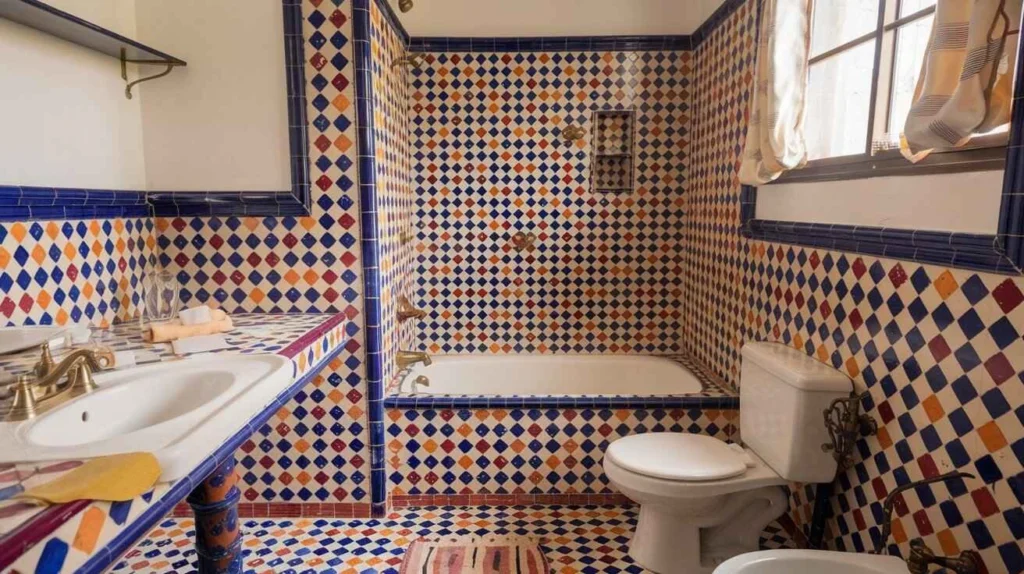
Moroccan-inspired tiles are the star of this design. They feature countless geometric patterns, elaborate designs, and brilliant colors like deep blues, burgundy reds, and bright yellows. Tiles in mosaic and hand-painted designs tend to be especially popular. When applied on floors or walls, they instantly exude a luxurious and dramatic vibe.
Tip
Consider covering your shower walls with Moroccan tiles to make them a statement feature. This will create a bold yet classy focal point in your bathroom that catches the eye. In a small bathroom, these nails can be used in smaller sections, for example, around the sink area or in the tub area.
Why It Works
The elaborate patterns and colors that are a signature of Moroccan bathroom tiles inject personality, warmth, and texture into your bathroom. An added benefit of wood and wood-like tiles is that they visually expand the space and make your bathroom feel more open and inviting when applied on the floor.
Luxurious Moroccan Vanity
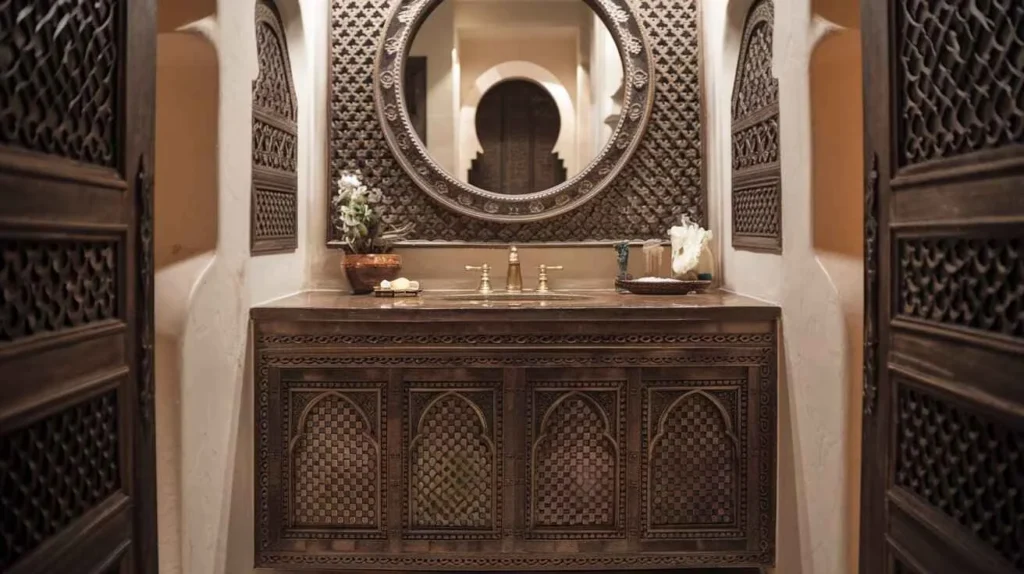
They are simple yet edgy, so a Moroccan vanity is an elegant and stylish addition to any bathroom. Choose an intricately carved wooden vanity with deep hues, common in traditional Moroccan designs. Most of these are usually in intricate detailing and breathtaking woodwork, contributing to the class of the room.
Tip
Drape the top with a large ornate mirror to make the most of this Moroccan vanity. The mirror will not only help add light and make your bathroom feel bigger. Still, it will also add a beautiful decorative element that looks pretty with your vanity.
Why it Works
You can give your bathroom a warm and inviting feel with a combination of detailed woodwork and a mirror that has an old-world charm. It also combines the Moroccan theme so your space feels cohesive and creates a luxurious feel.
Statement Moroccan Lantern Lighter
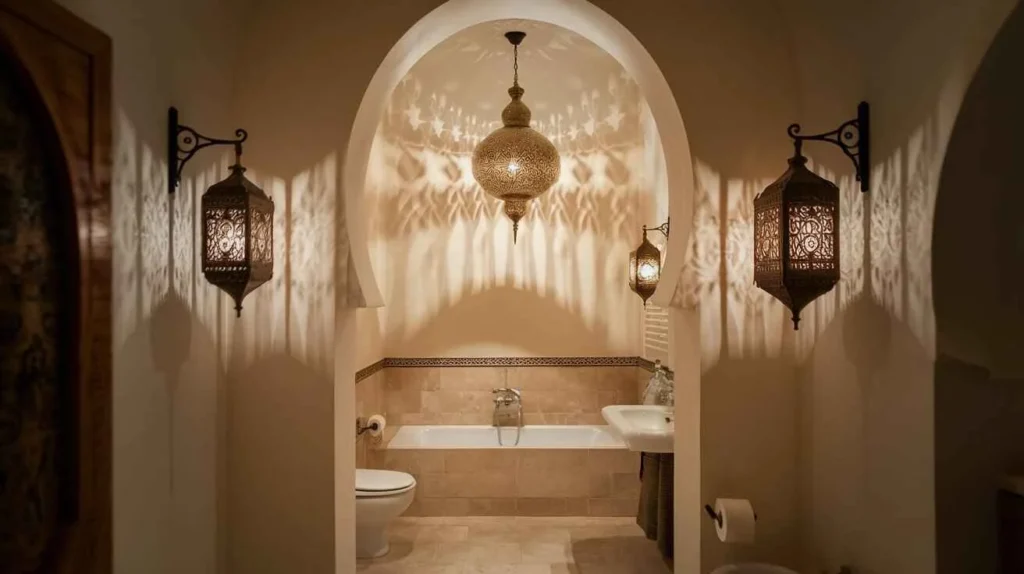
Note: Moroccan lanterns are a must-have for creating an authentic Moroccan bathroom. These decorative lights are often made from brass, copper, or iron. They cast a soft and warm glow, inviting a relaxing atmosphere. Moroccan lanterns vary greatly in shape and size, from individual sconces to elaborate hanging chandeliers.
Tip
To achieve a dynamic layered effect, suspend Moroccan lanterns in multiple sizes. The lanterns’ designs cast lovely shadows on the walls, contributing to the room’s exotic, spa-like quality.
Why it Works
The Moroccan lanterns provide ambient light that highlights the overall atmosphere and creates a sense of relaxation—ideal for bathrooms that are all about unwinding.
Deep Jewel Tones for Walls and Accents
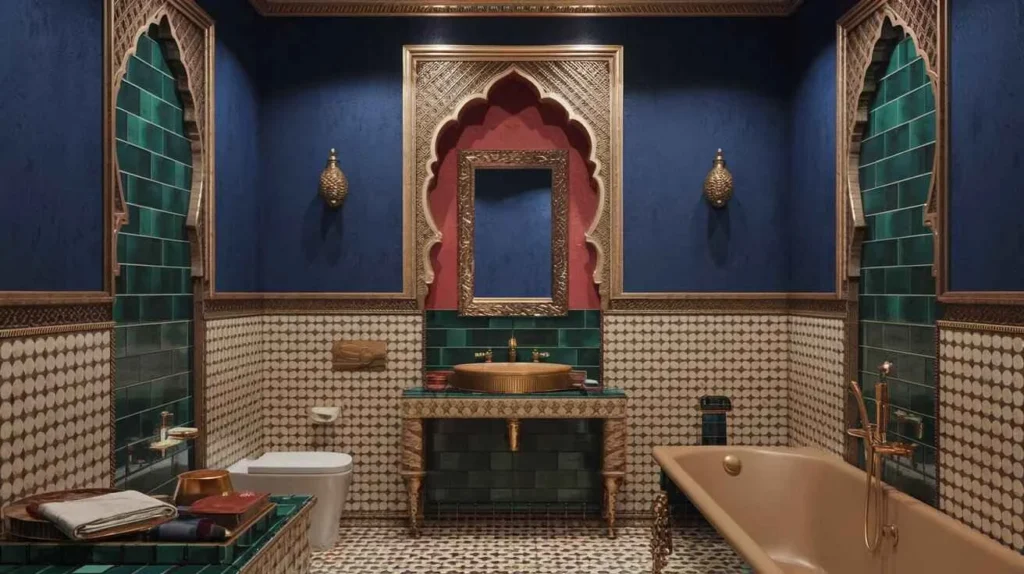
Sapphire blue, emerald green, ruby red, and amber jewel tones are common in Moroccan design. The rich, deep colors infuse warmth and vibrancy into even the humblest bathrooms and make them luxurious and exotic retreats.
Tip
Pair with gold or brass fixtures for added opulence. These jewel tones can be cloaked on the walls or work as accents in mirrors, shelving, or bath linens. To keep everything in balance, you can use these tones sparingly or ensure anything else in the space is neutral so as not to overstimulate the space.
Why it Works
The deep jewel tones impart a sense of royalty and sophistication, ideal for a Moroccan-inspired bathroom. These colors and metallic accents will give your bathroom an elegant and charming feel.
Moorish Hanging Bathroom Mirrors
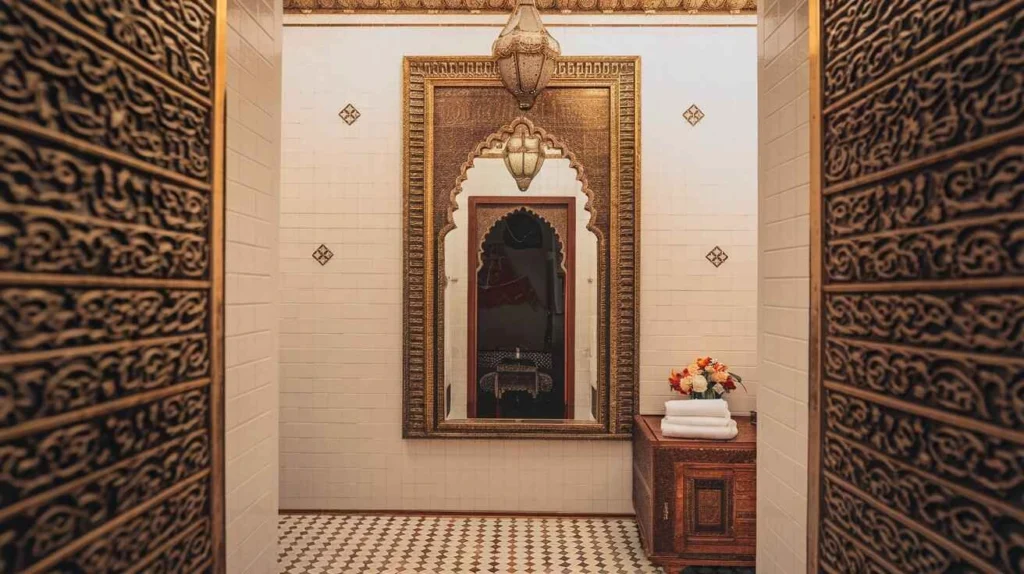
Ornate carved frames are characteristic of Moroccan mirrors. These mirrors are often constructed of metal or wood and adorned with arabesques, floral patterns, or geometric designs. Their distinctive frames are both functional and traditional touches of Moroccan style.
Tip
Select a mirror with a weathered gold or silver finish for an antiqued warmth in your room. A round or arched mirror can soften a room’s angular lines while adding a note of understated elegance.
Why It Works
Moroccan mirrors are functional and ornamental, so they’re a real showpiece in the lavatory. They immerse the space in beauty, grace, and depth, expanding the theme with intricate designs.
Shower Nooks, Hand-Painted Moroccan Tiles
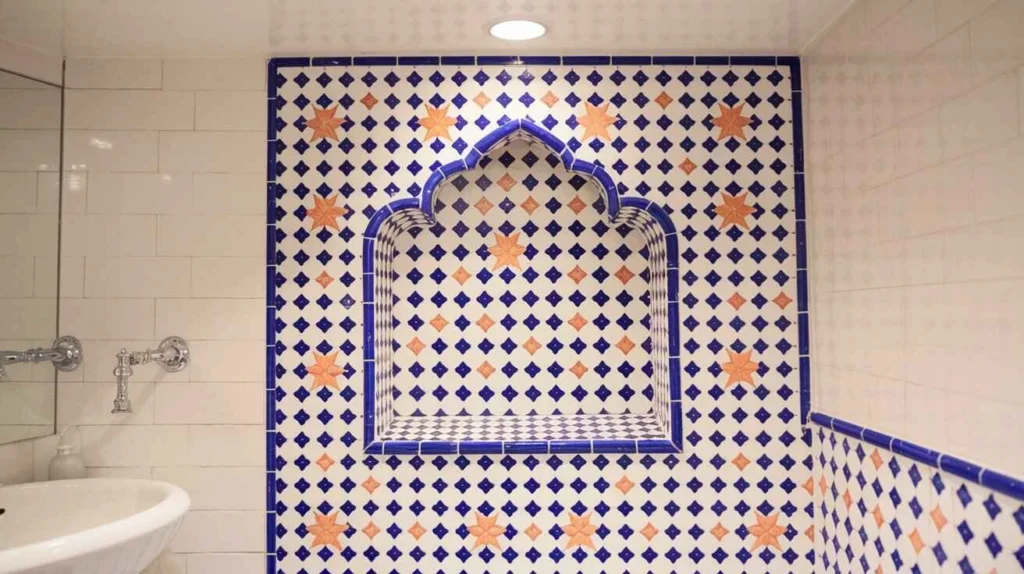
Use hand-painted Moroccan tiles inside your shower niche and accent shower walls for a unique punch. They often have beautiful Moroccan-inspired colors, patterns, and artisanal craftsmanship.
Tip
Consider selecting a color palette that works with the overall design of your bathroom and using similar tones in the rest of the bathroom to create a cohesive look. For a more subtle reference, hand-painted tiles in the shower nook offer an impactful feature without being overpowering and allow you to bring character to your bathroom.
Why it Works
Hand-painted tiles are artisanal, adding a personal touch to your bathroom. They are beautiful to look at and transform the space, giving it a more unique feel.
Moroccan Rugs to Add Warmth and Texture
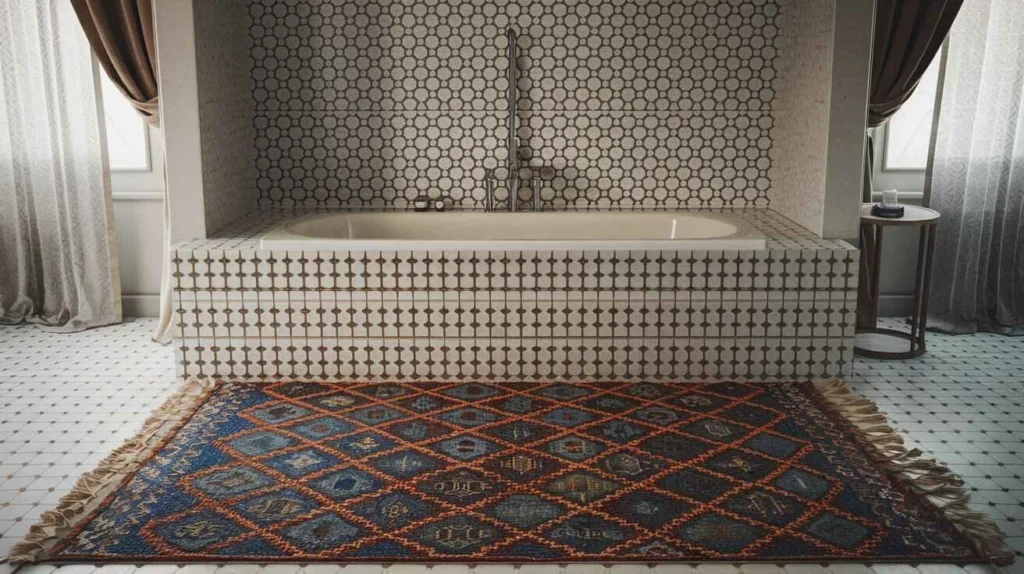
A Morrocan rug helps add warmth and texture to your bathroom. These rugs are usually intricately handwoven, peppered with rich colors, and designed to complement the Moroccan space. They also add pain and plushness underfoot to your bathroom floor, especially on chilly mornings.
Tip
If you have colorful tiles or other strong design elements you want to avoid clashing with, you can choose a neutral color rug to balance things out. A wool rug with geometric or tribal patterns could add texture and color to the room.
Why it Works
Moroccan rugs are soft to the touch and offer unique designs, adding both comfort and style to your bathroom. They add a soft, tactile texture in contrast to the hard surfaces of the tiles and fixtures, bringing warmth and coziness into the space.
Storage and Decoration: Woven Baskets
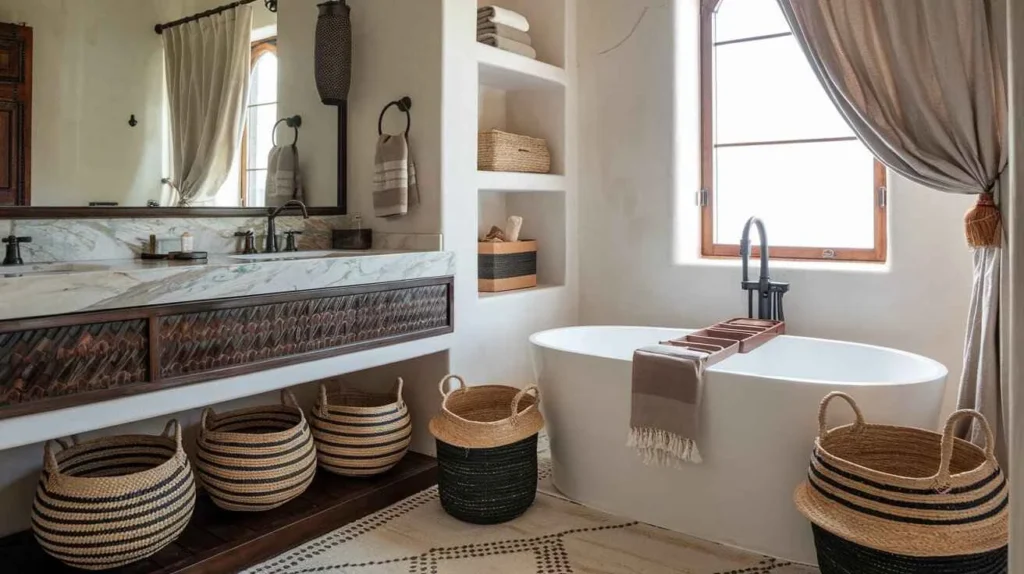
Use woven baskets made of natural fibers such as rattan, jute, or seagrass to store towels, toiletries, or other bathroom essentials. These baskets add to the room’s overall Moroccan aesthetic and provide functional storage.
Tip
Use flank baskets of different shapes and sizes for visual interest.) You can put them under a vanity, beside the bathtub, or on open shelves. Their raw nature brings some earthiness, which balances out the luxury in the space.
Why It Works
Moroccan baskets introduce a rustic, natural element to a room otherwise filled with sleek, modern fixtures. Their surface gives your bathroom a warm and authentic feel without failing to be practical.
Bath Fixtures Inspired by Morocco
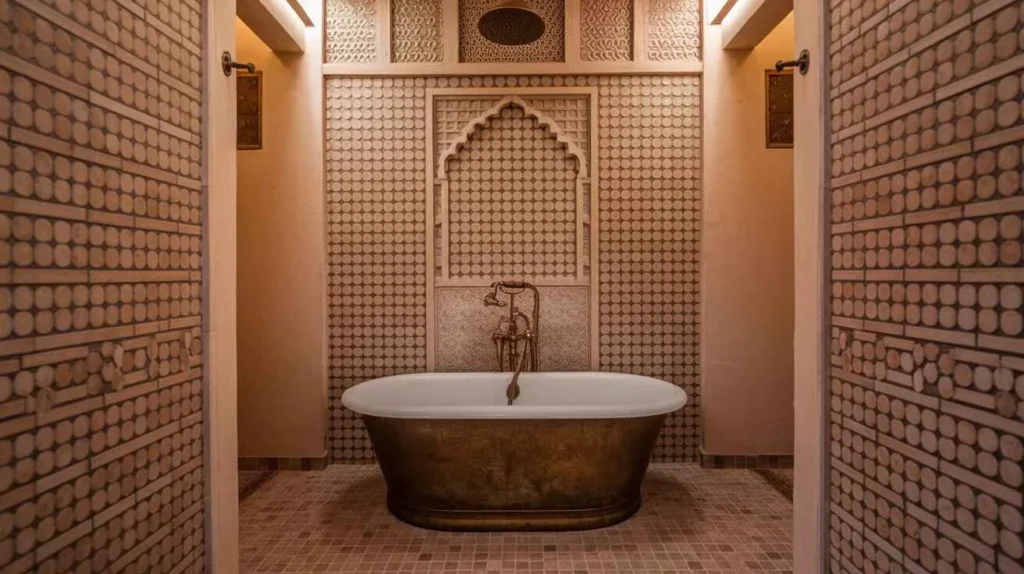
Transform your bathroom into a relaxing oasis with brass or bronze faucets and showerheads in Moroccan-inspired designs. The fixtures themselves usually have elegant curves and detailed engravings, which are very representative of Moroccan skilled craft. The brass and bronze accents bring sophistication and timeless beauty to any bathroom setting.
Tip
For a spa-like feel, complement these decorative fittings with a freestanding tub. Choose faucets with curved spouts or floral details to add to the Moroccan look. Surrounding the fixtures with soft, warm lighting will highlight their intricate patterns and add a soothing ambiance.
Why It Works
Brass and bronze are also beautiful and durable materials that look great in modern and traditional interiors. Moroccan-inspired fixtures with intricate detailing help draw the eye and add character and elegance to your bathroom. The freestanding tub with these fixtures enhances the overall decor, being stylish yet comfortable.
Ceramic Sinks in a Moroccan Motif
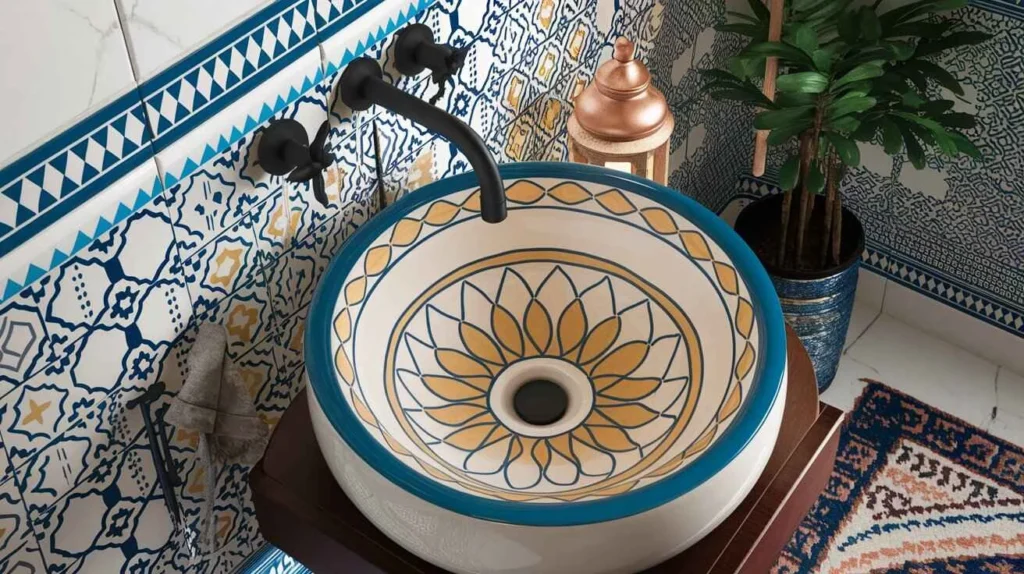
Replace your plain porcelain sink with a stunning Moroccan-pattern hand-painted ceramic sink to add color and style to your bathroom. Often decorated with intricate geometric patterns or bright colors, these sinks can be stunning centerpieces. The level of culture and personality they can inject into the area makes every trip to the commode a sonic experience.
Tip
Combine a vibrant ceramic sink with a minimalistic vanity or neutral countertops to let the sink shine. Mute the other pieces in the bathroom to balance the brightness of the sink. Settle for simple accessories that take the attention away from the beautiful handcrafted piece even more.
Why It Works
A Moroccan-inspired ceramic sink commands instant attention thanks to its bold colors and intricate design. These sinks reflect the craftsmanship and add an artistic, cultural vibe to the bathroom. And when paired with more modest elements, the sink’s beauty can shine, creating a balance of understated and eye-catching.
Moroccan Plaster for Textured Walls
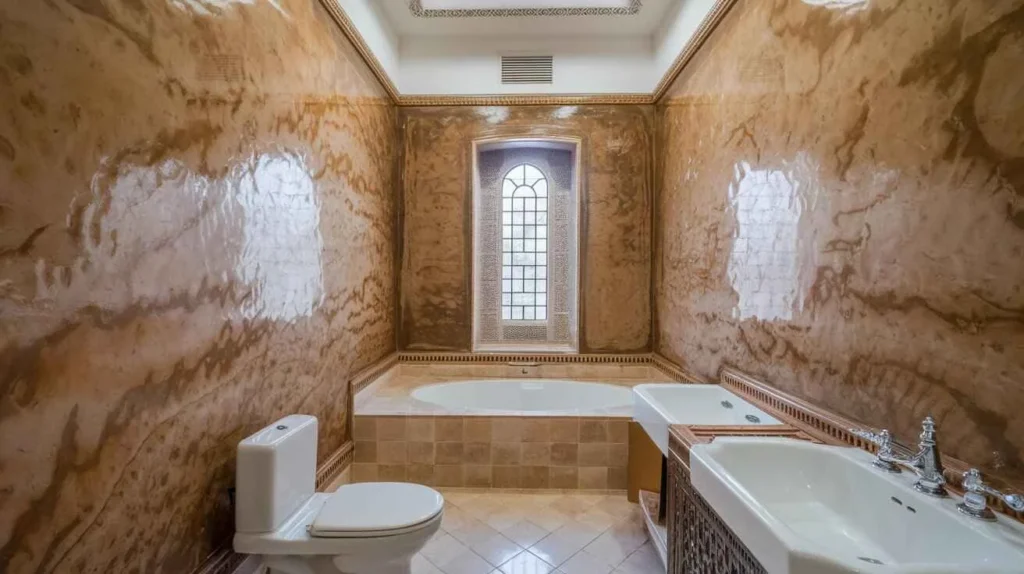
Tadelakt, or traditional Moroccan plaster, is a smooth, shiny wall finish that adds texture and dimension to your bath. This age-old practice creates a beautiful, continuous-looking finish but has some practical advantages: it’s water-resistant, making it an excellent option for bathrooms. The finish’s muted, organic tones create a tranquil and soothing atmosphere.
Tip
Use neutral tones such as beige, light gray, or soft peach for the tadelakt walls to encourage a calming environment. Emphasize the texture with selective lighting, like wall sconces or pendant lights that cast gentle shadows to accentuate the polished patina.
Why It Works
Tadelakt walls offer a balance of beauty and utility. The smooth but textured finish is visually striking and ideal for a spa-like sanctuary. Its inherent water resistance means it can be used in wet spaces. At the same time, the natural, earthy tones bring warmth and serenity to the bathroom.
Arched Doorways and Windows
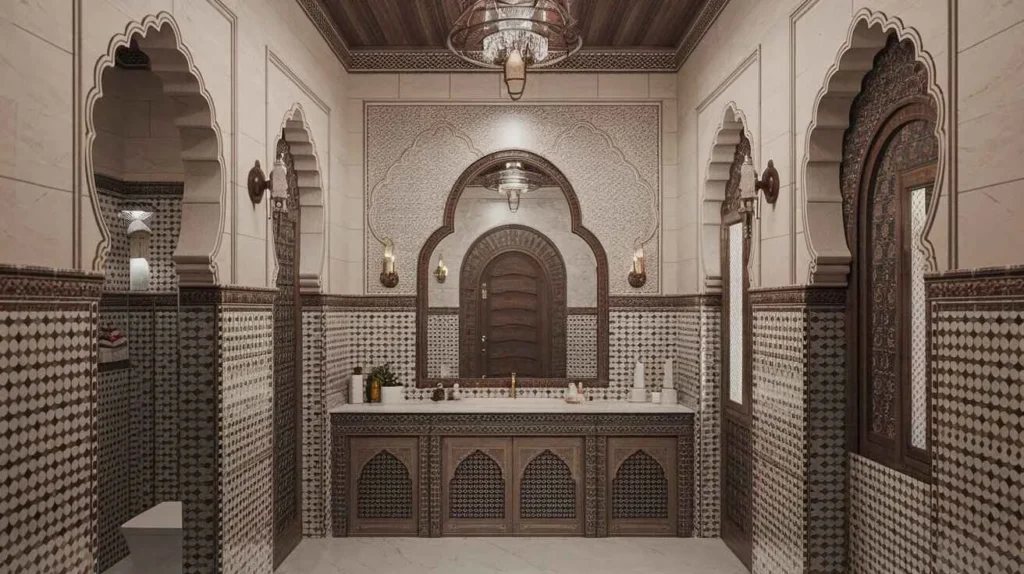
For a touch of Moroccan architecture, add arched doorways or windows to your bathroom design. These gentle, rounded forms are hallmark characteristics of classical Moroccan architecture and contribute to the space’s charm and elegance. The curved forms provide a break from monotonous straight lines and also create a more inviting, dynamic environment.
Tip
If you can’t make structural changes, use architectural details such as arched mirrors or decorative frames to mimic this effect. The arches can also frame key areas, such as the vanity or shower area, making the space work aesthetically and practically and adding depth and drama to the elegant design.
Why It Works
Arched designs soften a bathroom’s overall appearance, giving it a cozier, inviting feel. This vital trick creates a perception of height and openness, which is especially important in smaller spaces. It is both functional and beautiful, a nod to traditional Moroccan architecture.
Moroccan Tiled Backsplash
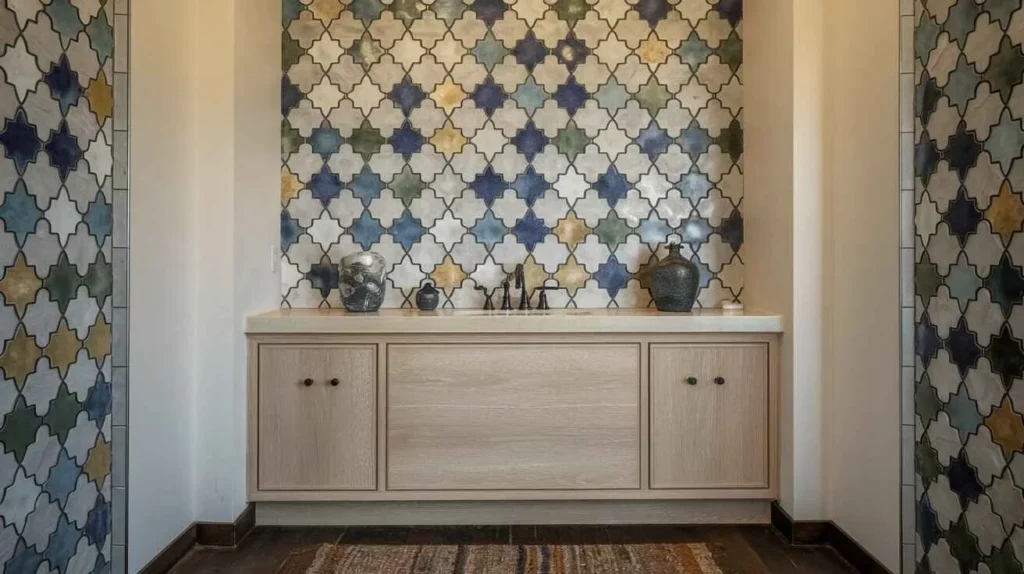
Introducing a Moroccan-inspired tiled backsplash behind your bathroom vanity or sink is a great way to inject some color and patterns into the space. Moroccan tiles are recognized for their geometric and floral designs, which often feature bold contrasting shades of blue, white, green, and gold. This aspect turns the room into a work of art in no time.
Tip
Opt for bold, contrasting color combinations like cobalt blue with white or teal with gold for impact. Be judicious in applications, like on a backsplash or feature wall, so the design doesn’t feel overwhelming.” Always keep the grout lines clean for a professional and polished look.
Why It Works
Moroccan tiles’ cultural richness and artistry make the bathroom feel vibrant and personalized. The elaborate designs and vibrant colors draw the eye, and the tile’s strength makes it a smart pick for high-moisture regions. This blend of aesthetics and practicality makes the whole space more attractive.
Bright, Boho Moroccan Shower Curtains
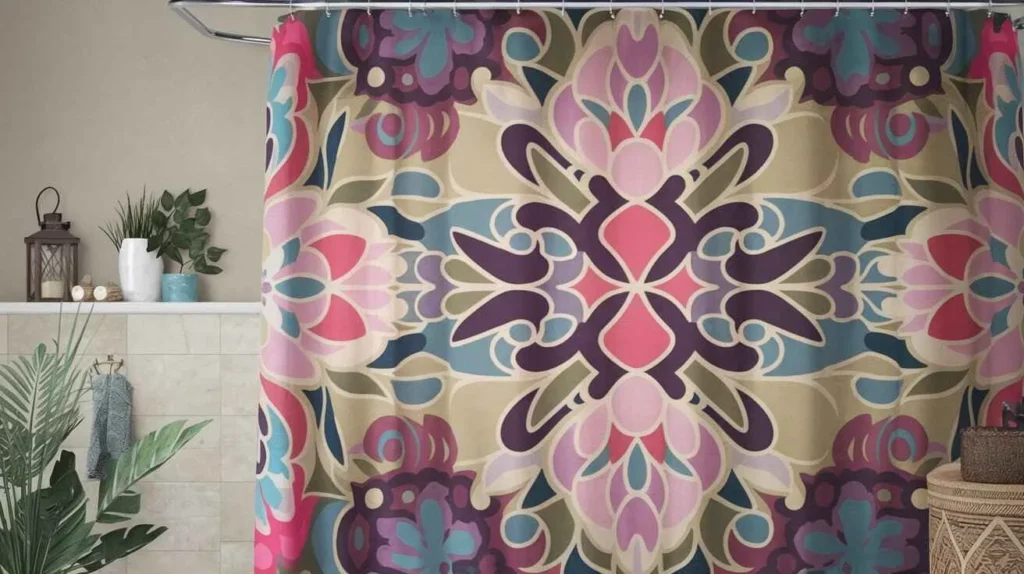
Bring a Moroccan vibe into the bathroom with a bohemian-style shower curtain adorned with intricate Moroccan patterns. These curtains are typically made from large-scale floral or geometric prints and bright colors , providing an inexpensive and easy way to dress up the room.
Tip
For an authentic look, wear lightweight fabrics in delicate, detailed patterns. Mix neutral walls and minimal decor with the curtain to keep the space from feeling overwhelmed. This will create an even and pleasing aesthetic while allowing the curtain to take the stage as the main piece of the room.
Why It Works
Moroccan-style shower pants bring color and individuality to the bathroom without major renovations. They can be a relatively inexpensive way to give the space a cultural feel and are easy to replace if you want a new look. The bohemian flair goes well with just about any decor style, from modern to eclectic.
Moroccan-Style Walls Using Paint and Stencils
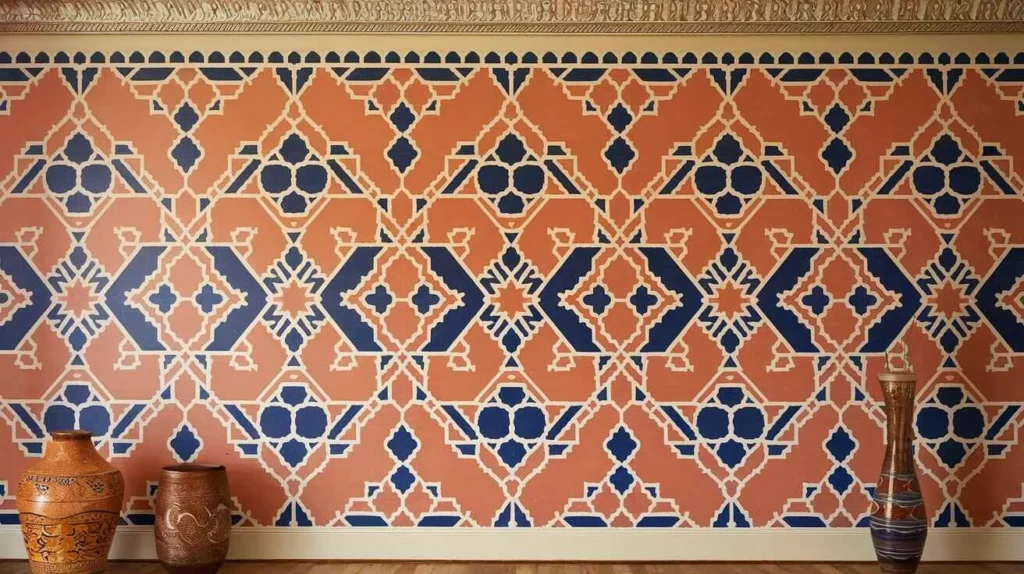
A painted wall with an ornate Moroccan pattern done via stencils. This DIY-tastic method of painting allows you to recreate traditional Moroccan tile designs and achieve an eye-catching effect. Stencils also incorporate patterns—florals, geometrics, or even lattice-like designs offering depth and texture.
Tip
For an upper-crust yet understated appearance, pair metallic paints such as gold or bronze with a neutral base color. Try one feature wall or stencil a border around the room for a cohesive look. It is cost-efficient, plus you can snap it up in any color you want.
Why It Works
Painted Moroccan patterns are an excellent way to embellish Moroccan decor without paying for cost or labor by replacing tiles. The patterns provide movement and energy to the walls yet are customizable and adaptable to any space. This easy DIY option is a great way to bring authenticity and artistry to your bathroom.
How to Create the Perfect Moroccan Bathroom Look
A Blend of Old School and New School
Combine Moroccan elements such as decorative tiles, brass fixtures, or arched details with modern design components, like minimalist vanities or sleek lighting. Textural richness and color are essential to that balance, bringing in elements of local design that are timeless yet updated, tradition-rich yet modernly influenced.
DIY vs. Professional Help
You can do simple updates, such as painting the walls with Moroccan stencils or adding a tiled backsplash, as DIY projects. It is better to enlist professionals who deliver quality and durability for work such as tadelakt plastering and laying elaborate tile designs.
Consider Your Bathroom Size
Scale Moroccan elements to fit your bathroom’s size. Smaller bathrooms will use smaller accents, like a patterned mirror or sink (for example). In comparison, larger bathrooms can include more dramatic features such as a freestanding tub, arched windows, or tiled feature walls.
Maximizing Light and Space
Mirrors, light-colored walls, and well-placed lighting, such as Moroccan-style sconces, make the bathroom seem larger and brighter. Arched windows or large mirrors can also reflect light and showcase the details of your design.
Mistakes You Should Be Aware of When Designing a Moroccan Bathroom
Overdoing Patterns and Colors
Avoid going overboard with bold patterns or colors, as they can get overwhelming in a bathroom. Pair bold Moroccan designs with neutral tones to keep the look elegant and harmonious.
Neglecting Functionality
Practicality should not be sacrificed to style. Consider storage solutions, simple-to-affix materials, and functional layouts that make the bathroom as pleasant as it is user-friendly.
Not Considering Bathroom Size
Big Moroccans in a small bathroom can feel overwhelming, while not enough detail in a large bathroom can feel sparse. Adjust the scale of your design elements to suit the size of the space.
Conclusion
A Moroccan bathroom celebrates color, patterns, and textures while retaining a core of functionality. From tiles to tadelakt finishes, you can transform your bathroom into a calm retreat; each detail can be a part of your spa experience.
Begin with a small accent sink or colorful mirror, or go big with a tiled wall or arched doorway. One step takes you there, and the final step brings you into a unique, relaxing environment.
Do research, consult with professionals if you need such assistance, and browse through Moroccan designs that suit your space. Start today on creating a stylish yet functional bathroom!
Moroccan-Style Bathrooms — 7 FAQs
So, what does a Moroccan-style bathroom look like?
Moroccan-style bathrooms use a lot of bold colors, detailed tile and tile patterns, geometric shapes, plush textures, hand-carved furnishings and ambient lighting in the form of Moroccan lanterns. That makes for a very calm and exotic feeling.
How can I use Moroccan tiles in my bathroom?
Try Moroccan tiles on the floor or wall, or even inside the shower for a statement. Bright colors — turquoise, deep blue, reds and yellows; and geometric patterns bring brightness and texture to the space.
Which materials work well for Moroccan style bathroom fittings?
Brass, bronze and ceramic are best for faucets, showerheads and sinks. These materials create sophistication and classic beauty, sometimes featuring elaborate detailing that expresses Moroccan artistry.
Will Moroccan design in a small bathroom?
Yes, Moroccan design can fit into tiny bathrooms, too. Consider using smaller accent pieces such as colorful mirrors, hand-painted sinks, or patterned backsplashes to create an impactful statement without making the space feel overstated.
What is Tadelakt plaster? And how is it used in Moroccan bathrooms?
For example, Tadelakt plaster has a time-tested history in Morocco and can result in a smooth, shiny finish. It’s water-resistant, ideal for bathroom walls, bringing depth and a calm vibe to the space.
What is good lighting in Moroccan bathroom design?
Moroccan lanterns and sconces in brass or copper are perfect for casting a warm, inviting glow. Just like Moroccan bathrooms, layered, dimmable lighting will help create the relaxing, intimate space.
How do I incorporate Moroccan warmth and texture without a full renovation?
New and simple accessories — woven baskets, colorful towels, a Moroccan-style shower curtain or hand-painted ceramic sinks — can also add Moroccan flair to your bathroom without extensive renovations.
Also Read: 15 Luxury Bedroom Design: White Black Headboard Minimal Style

